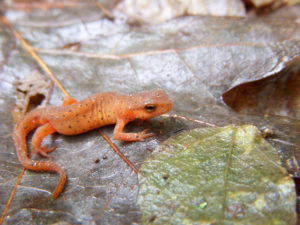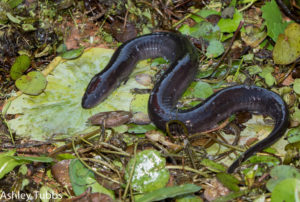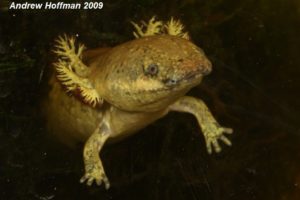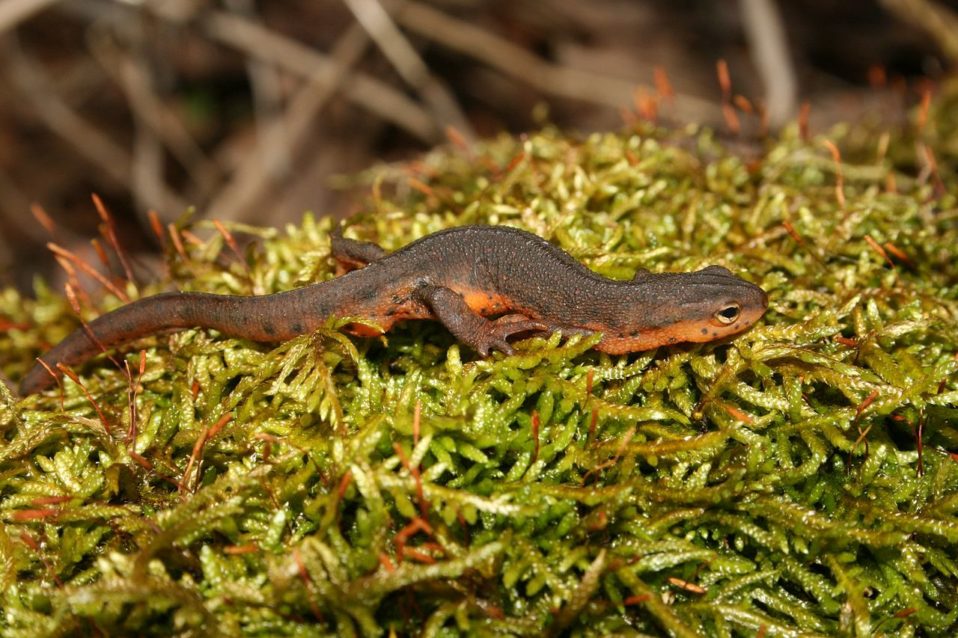Wildlife Wednesday: Houston Area Salamanders
Salamanders are an underappreciated and overlooked group of amphibians. That’s because they often lead secretive lives underground, down in the mud, and underwater. As with frogs, salamanders undergo metamorphosis, in which their shell-less eggs are laid in a wet location (often in a pond), they go through an aquatic larval stage (the tadpole stage), and then become air-breathing adults. Also like frogs, they have semi-permeable skin that allows water to pass in and out, so they can dry out easily, but can also drink through their skin. Some adult salamanders “breathe” or respire using lungs, while others use gills, and a group called the “lungless salamanders” breathe through their skin and the lining of their mouths.
Though they are seldom seen around Houston, there are several species of salamander found in the area. Here’s a survey of 3 of the more common species.
 The Central Newt (Nothophthalmus viridescens louisanensis) is a small aquatic salamander that lives in still freshwater habitats. They actually have 4 life stages: 1. The eggs are laid on vegetation in the water. 2. The gilled tadpoles/larvae stay in the water while they develop. 3. After a number of months, the larvae change into a reddish orange terrestrial stage called an “eft”. They live in forested habitats for 1 – 3 years like this. 4. Eventually, they change to their adult yellow-olive brown coloration, and go back into a pond to live out their adult lives in the water. The Eastern newts of North America (which this is a subspecies of) are the only salamanders which go through this terrestrial eft stage, though some newts in other parts of the world are terrestrial as adults. As with all salamanders, Central Newts are carnivorous, eating a wide variety of small invertebrates.
The Central Newt (Nothophthalmus viridescens louisanensis) is a small aquatic salamander that lives in still freshwater habitats. They actually have 4 life stages: 1. The eggs are laid on vegetation in the water. 2. The gilled tadpoles/larvae stay in the water while they develop. 3. After a number of months, the larvae change into a reddish orange terrestrial stage called an “eft”. They live in forested habitats for 1 – 3 years like this. 4. Eventually, they change to their adult yellow-olive brown coloration, and go back into a pond to live out their adult lives in the water. The Eastern newts of North America (which this is a subspecies of) are the only salamanders which go through this terrestrial eft stage, though some newts in other parts of the world are terrestrial as adults. As with all salamanders, Central Newts are carnivorous, eating a wide variety of small invertebrates.
The large 3-Toed Amphiuma (Amphiuma tridactylum) doesn’t even look like a salamander! You’d be forgiven for thinking it was a eel. They are long bodied (up to almost 4 ft), aquatic, and their 4 tiny limbs are so small, that you’d only see them upon close inspection. They are highly carnivorous, eating a wide variety of fish, other amphibians, reptiles, and large invertebrates. Though salamanders are basically tooth-less, amphiumas have a sharp bony ridge in their mouths, which they use for defense and predation. Also unlike other salamanders, they are known to emit a squeaky bark noise, when molested.
 Another fully aquatic eel-like salamander is the Lesser Siren (Siren intermedia), which grow to about 18 inches in length. They have 2 tiny front legs, no back legs, and a flattened paddle-like tail. Sirens are easily identified by their feathery gray and red external gills, which extend from the sides of the head. Much like the amphiuma, they are very carnivorous and can deliver a painful and bloody bite. However, instead of a sharp bony ridge, they have a sharp horny beak-like structure. Also similar to amphiumas, they have extremely smooth slimy skin. Both sirens and amphiumas are believed to guard their eggs in mud nests under the water or in burrows next to their ponds, lakes, and bayous.
Another fully aquatic eel-like salamander is the Lesser Siren (Siren intermedia), which grow to about 18 inches in length. They have 2 tiny front legs, no back legs, and a flattened paddle-like tail. Sirens are easily identified by their feathery gray and red external gills, which extend from the sides of the head. Much like the amphiuma, they are very carnivorous and can deliver a painful and bloody bite. However, instead of a sharp bony ridge, they have a sharp horny beak-like structure. Also similar to amphiumas, they have extremely smooth slimy skin. Both sirens and amphiumas are believed to guard their eggs in mud nests under the water or in burrows next to their ponds, lakes, and bayous.
Thanks for exploring a few of the local salamander species with us this week. While you may not encounter any wild salamanders in our park, many of our larger and wilder Houston area parks and nature centers offer chances to find these 3 species. And if you’ve never seen a live salamander up close, we invite you to visit the Nature Discovery Center some time, and get to know Sherman, our friendly Barred Tiger Salamander.
See you soon!
Eric Duran
Staff Naturalist
photos: Adult newt – Psyon | Wikimedia; Newt eft – Corey Raimond | Flickr; Amphiuma – Ashley Tubbs | Flickr; Siren – Andrew Hoffman and Zeke Franco on Flickr



